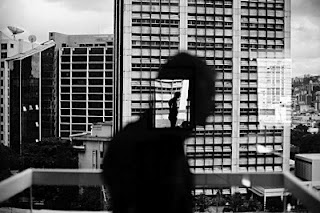


For my studio lighting project, a couple of yawns caught on camera and a hell of a lot of rearranging lights, and I finally results I liked. I used Andie as my model in all three pictures, and had her play around with faces and angles. Taking the first picture at the top for example. Using a Nikon d3100, with a shutter speed of 1/80, and an aperture of F-5.6. I set my lighting at a 1:2 ratio, and was of course, formally posed, using two studio lights. This one ended up being my favourite because I loved the way the light Andie's looking into sharpens the profile of her face, and her long hard is dark enough to contrast well with that. It has a classy, elegant look to it, unlike the other pictures I took of her with a little more freedom to make weird faces and poses. The catch light in her eyes gives depth to the photo, and draws your eyes in.
In the second photo, it was taken candidly, as the subject was just making different faces at the camera, and I decided not to tell her when I was going to take the picture. For this one, I used the Nikon D3100, with a shutter speed of 1/80 and an aperture of F-5.6. I love the way her hair against her arm contrasts, as well as with her face. I had a light closer to her on the left, and farther away on the right, as you can see through the darker shadows on the right.
For the last studio lighting picture, using a Nikon D3100, with a shutter speed of 1/80, and an aperture of F-5.6, I let Andie play around (with her hair apparently), and shot candid pictures while she did so. I used two studio lights, the one on the left is once again stronger, because I set it closer than I did with the one on the right, but I did it so that you could hardly tell, because I wanted her entire face to be lit similarly. I love the contrast between her eyes and her fancy strand of hairstache.

